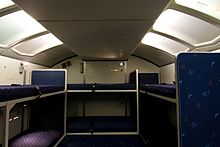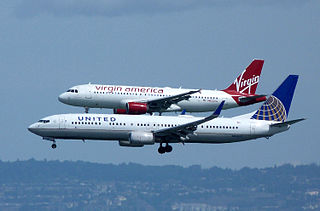
An airliner is a type of aircraft for transporting passengers and air cargo. Such aircraft are most often operated by airlines. Although the definition of an airliner can vary from country to country, an airliner is typically defined as an airplane intended for carrying multiple passengers or cargo in commercial service. The largest of them are wide-body jets which are also called twin-aisle because they generally have two separate aisles running from the front to the back of the passenger cabin. These are usually used for long-haul flights between airline hubs and major cities. A smaller, more common class of airliners is the narrow-body or single-aisle. These are generally used for short to medium-distance flights with fewer passengers than their wide-body counterparts.
The Federal Aviation Regulations (FARs) are rules prescribed by the Federal Aviation Administration (FAA) governing all aviation activities in the United States. The FARs comprise Title 14 of the Code of Federal Regulations (CFR). A wide variety of activities are regulated, such as aircraft design and maintenance, typical airline flights, pilot training activities, hot-air ballooning, lighter-than-air aircraft, man-made structure heights, obstruction lighting and marking, model rocket launches, commercial space operations, model aircraft operations, Unmanned Aircraft Systems (UAS) and kite flying. The rules are designed to promote safe aviation, protecting pilots, flight attendants, passengers and the general public from unnecessary risk.

The Boeing 777, commonly referred to as the Triple Seven, is an American long-range wide-body airliner developed and manufactured by Boeing Commercial Airplanes. The 777 is the world's largest twinjet and the most-built wide-body airliner. The jetliner was designed to bridge the gap between Boeing's other wide body airplanes, the twin-engined 767 and quad-engined 747, and to replace aging DC-10 and L-1011 trijets. Developed in consultation with eight major airlines, the 777 program was launched in October 1990, with an order from United Airlines. The prototype was rolled out in April 1994, and first flew in June. The 777 entered service with the launch operator United Airlines in June 1995. Longer-range variants were launched in 2000, and first delivered in 2004.

An aviation accident is defined by the Convention on International Civil Aviation Annex 13 as an occurrence associated with the operation of an aircraft, which takes place from the time any person boards the aircraft with the intention of flight until all such persons have disembarked, and in which (a) a person is fatally or seriously injured, (b) the aircraft sustains significant damage or structural failure, or (c) the aircraft goes missing or becomes completely inaccessible. Annex 13 defines an aviation incident as an occurrence, other than an accident, associated with the operation of an aircraft that affects or could affect the safety of operation.

The Airbus A340 is a long-range, wide-body passenger airliner that was developed and produced by Airbus. In the mid-1970s, Airbus conceived several derivatives of the A300, its first airliner, and developed the A340 quadjet in parallel with the A330 twinjet. In June 1987, Airbus launched both designs with their first orders and the A340-300 took its maiden flight on 25 October 1991. It was certified along with the A340-200 on 22 December 1992 and both versions entered service in March 1993 with launch customers Lufthansa and Air France. The larger A340-500/600 were launched on 8 December 1997; the A340-600 flew for the first time on 23 April 2001 and entered service on 1 August 2002.

The Airbus A380 is a very large wide-body airliner that was developed and produced by Airbus. It is the world's largest passenger airliner and only full-length double-deck jet airliner. Airbus studies started in 1988, and the project was announced in 1990 to challenge the dominance of the Boeing 747 in the long-haul market. The then-designated A3XX project was presented in 1994; Airbus launched the €9.5 billion ($10.7 billion) A380 programme on 19 December 2000. The first prototype was unveiled in Toulouse on 18 January 2005, with its first flight on 27 April 2005. It then obtained its type certificate from the European Aviation Safety Agency (EASA) and the US Federal Aviation Administration (FAA) on 12 December 2006.

A wide-body aircraft, also known as a twin-aisle aircraft and in the largest cases as a jumbo jet, is an airliner with a fuselage wide enough to accommodate two passenger aisles with seven or more seats abreast. The typical fuselage diameter is 5 to 6 m. In the typical wide-body economy cabin, passengers are seated seven to ten abreast, allowing a total capacity of 200 to 850 passengers. Seven-abreast aircraft typically seat 160 to 260 passengers, eight-abreast 250 to 380, nine- and ten-abreast 350 to 480. The largest wide-body aircraft are over 6 m (20 ft) wide, and can accommodate up to eleven passengers abreast in high-density configurations.

The Boeing 787 Dreamliner is an American wide-body jet airliner developed and manufactured by Boeing Commercial Airplanes. After dropping its unconventional Sonic Cruiser project, Boeing announced the conventional 7E7 on January 29, 2003, which focused largely on efficiency. The program was launched on April 26, 2004, with an order for 50 aircraft from All Nippon Airways (ANA), targeting a 2008 introduction. On July 8, 2007, a prototype 787 was rolled out without major operating systems, and then the aircraft experienced multiple delays until its maiden flight on December 15, 2009. Type certification was received in August 2011 and the first 787-8 was delivered in September 2011 before entering commercial service on October 26, 2011, with ANA.
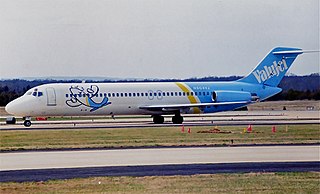
ValuJet Airlines Flight 592 was a regularly scheduled flight from Miami to Atlanta. On May 11, 1996, the ValuJet Airlines McDonnell Douglas DC-9 operating the route crashed into the Everglades about 10 minutes after departing Miami as a result of a fire in the cargo compartment possibly caused by mislabeled and improperly stored hazardous cargo. All 110 people on board were killed. The airline already had a poor safety record before the crash, and the accident brought widespread attention to the airline's problems. ValuJet's fleet was grounded for several months after the accident. When operations resumed, the airline was unable to attract as many customers as it had before the accident. It acquired AirTran Airways in 1997, but the lingering damage to the ValuJet name led its executives to assume the AirTran name.

ETOPS is an acronym for Extended-range Twin-engine Operations Performance Standards—a special part of flight rules for one-engine-inoperative flight conditions. The International Civil Aviation Organization (ICAO) coined the acronym for twin-engine aircraft operation in airspace further than one hour from a diversion airport at the one-engine-inoperative cruise speed, over water or remote lands, or on routes previously restricted to three- and four-engine aircraft.

Aviation safety is the study and practice of managing risks in aviation. This includes preventing aviation accidents and incidents through research, educating air travel personnel, passengers and the general public, as well as the design of aircraft and aviation infrastructure. The aviation industry is subject to significant regulation and oversight.

The Airbus A350 is a long-range, wide-body twin-engine jet airliner developed and produced by Airbus. The first A350 design proposed by Airbus in 2004, in response to the Boeing 787 Dreamliner, would have been a development of the Airbus A330 with composite wings and new engines. As market support was inadequate, in 2006, Airbus switched to a clean-sheet "XWB" design, powered by two Rolls-Royce Trent XWB high bypass turbofan engines. The prototype first flew on 14 June 2013 from Toulouse, France. Type certification from the European Aviation Safety Agency (EASA) was obtained in September 2014, followed by certification from the Federal Aviation Administration (FAA) two months later.
An uncontrolled decompression is an undesired drop in the pressure of a sealed system, such as a pressurised aircraft cabin or hyperbaric chamber, that typically results from human error, structural failure, or impact, causing the pressurised vessel to vent into its surroundings or fail to pressurize at all.
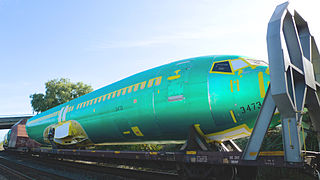
Cabin pressurization is a process in which conditioned air is pumped into the cabin of an aircraft or spacecraft in order to create a safe and comfortable environment for humans flying at high altitudes. For aircraft, this air is usually bled off from the gas turbine engines at the compressor stage, and for spacecraft, it is carried in high-pressure, often cryogenic, tanks. The air is cooled, humidified, and mixed with recirculated air by one or more environmental control systems before it is distributed to the cabin.

A pre-flight safety briefing is a detailed explanation given before take-off to airline passengers about the safety features of the aircraft they are aboard.

An airline seat is a seat on an airliner in which passengers are accommodated for the duration of the journey. Such seats are usually arranged in rows running across the airplane's fuselage. A diagram of such seats in an aircraft is called an aircraft seat map.

A type rating is an authorization entered on or associated with a pilot license and forming part thereof, stating the pilot's privileges or limitations pertaining to certain aircraft type. Such qualification requires additional training beyond the scope of the initial license and aircraft class training.
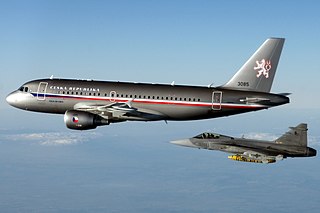
Airbus Corporate Jets, a business unit of Airbus SAS and part of Airbus, markets and completes corporate jet variants from the parent's airliner range. Types include the A318 Elite to the double/triple-decked Airbus A380 Prestige. Following the entry of the 737-based Boeing Business Jet, Airbus joined the business jet market with the A319 Corporate Jet in 1997. Although the term Airbus Corporate jet was initially used only for the A319CJ, it is now often used for all models, including the VIP widebodies. As of June 2019, 213 corporate and private jets are operating; 222 aircraft have been ordered, including 128 A320 family jets.

Lufthansa Technik AG provides worldwide maintenance, repair, and overhaul (MRO) services for aircraft, engines, and components. It is a subsidiary of the Lufthansa Group.
This is a list of aviation-related events in 2018.
